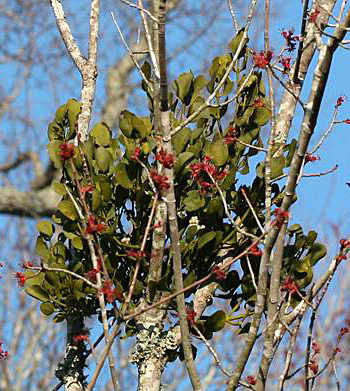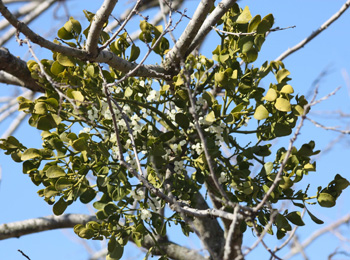Contents:
Common Names | Parts Usually Used | Plant(s) & Culture | Where Found | Medicinal Properties
Legends, Myths and Stories | Uses | Formulas or Dosages | Warning | Bibliography
Scientific Names

American Mistletoe |
- Phoradendron serotinum L.
- Phoradendron flavescens L.
- Viscum album
- Loranthaceae
Common Names
Phoradendron serotinum common names:
- American mistletoe
- Birdlime
- Golden bough
Viscum album common names:
- All-heal
- Birdlime
- Devil’s fuge
- European mistletoe
Parts Usually Used
American mistletoe: Leaves
European mistletoe: Plant, berries, young twigs
Back to Top
Description of Plant(s) and Culture

European Mistletoe |
American mistletoe: An evergreen, semi-parasitic plant that grows on other trees, most commonly the poplar and the apple. It bears small yellow flowers in early spring, but better known are its pearly berries. The branching woody stem is swollen at the nodes and bears opposite, leathery, yellowish-green, obovate to elliptic leaves which are hairy when young but glabrous at maturity. The flowers grow in jointed spikes, developing into mucilaginous, white berries.
European mistletoe: An evergreen, semiparasitic plant found on the branches of deciduous trees. Roots growing from the yellowish-green, forked stem penetrate through the bark into the wood of the host. The leaves are opposite, leathery, yellow-green, and narrowly obovate. Pale yellow or green flowers appear from March to May, the female developing into sticky white berries which ripen from September to November.
The Chinese mistletoe (Loranthus yadoriki) Sang-chi-sheng; or (Lorantus kempferi) Sung-lo.
Back to Top
Where Found
American mistletoe: Eastern, southern and western United States.
European mistletoe: Found in Europe and northern Asia.
Back to Top
Medicinal Properties
American mistletoe: Emetic, nervine.
European mistletoe: Cardiac, diuretic, stimulant, vasodilator, narcotic, antispasmodic, nervine
Back to Top
Legends, Myths and Stories
Mistletoe is an evergreen shrub which clings to its host tree high up among the branches and gains its nourishment by penetrating the bark of its host with its roots and purloining what sap it requires. It is peculiar in the manner of its growth. The branches turn always toward the object to which the plant is attached, a curious habit which made the ancients think of it as a visible god protecting its sacred tree and which aroused in all early peoples so much of wonder.
Mistletoe (the “golden bough”) was chief of the seven sacred herbs of the Druids, and others being vervain, henbane, primrose, pulsatilla, clover and wolf’s bane. Readers keen to follow the Druidic example should gather their mistletoe on the sixth day of the moon’s waning.
Mistletoe appears in many Greek and Roman myths, and is reputed to have been used to make Christ’s cross (Viscum album).
Often of religious importance, mistletoe figured in folk lore tales and mythology in every country where it grew.
The power of this herb is of renewing itself when cut, one reason why it was held in mystic honor. In all countries it was worshipped as the soul and embodiment of the holy forest. To the Norseman only the “mistil” could inflict injury on the Sun God, Baldur; to the Roman only the “viscuan” could unlock the door of Hades for Aeneas to enter; to the English Druids only “Misleta” cut from an oak by the light of the moon could give protection to man.
Culpeper spelled this herb as misselto.
Back to Top
Uses
American mistletoe: Used for cholera, epilepsy, convulsions, hysteria, delirium, heart problems, and nervous debility. The Native Americans used it to cause abortion. An extract of the plant is known to increase uterine contractions and raise blood pressure when injected into the blood. The plant has also been used medicinally to stop bleeding after parturition (after childbirth). Also used as an oral contraceptive.
European mistletoe: In olden times, mistletoe was the accepted treatment for dropsy and epilepsy, although nowadays its commonest use is to strengthen the nerves and improve the circulation. A good heart tonic and antisclerotic, it also raises the blood pressure and speeds up the pulse, do not take mistletoe if high blood pressure is present. Combined with bear’s garlic and hawthorn it will safely arrest, perhaps even cure, the progress of hardening of the arteries and high blood pressure. Has been used to treat epilepsy, convulsions, hysteria, delirium, and St. Vitus dance.
The tea can be used as a wash for chilblains (inflammation, itching, and swelling of the feet, toes, or fingers caused by mild frostbite), and leg ulcers and made into a compress for varicose veins.
Back to Top
Formulas or Dosages
European mistletoe:
Prepare an infusion of the leaves and young branches (diced), using 1 tsp. of herb to 1 pint of water. It is unnecessary to allow it to steep more than 30 minutes. The dosage is 1 tbsp. daily, increasing to 3 if no improvement is shown. Not recommended for children.
The juice from mistletoe berries dabbed on obstinate pimples will cause them to disappear. And it will also loosen stiff joints when massaged into the skin.
Cold Extract:
1. soak 1 tsp. young twigs in 1 cup of cold water for 24 hours. Take 1 cup per day, in 3 equal parts morning, noon, and night.
2. soak 6 tsp. leaves in 1 1/2 cups cold water for 6 to 8 hours. Take 1 1/2 cups in the course of a day, a mouthful at a time.
Juice: Wet the leaves and young twigs. When the water has been absorbed, press to extract the juice. Take 2 to 4 tsp. per day.
Back to Top
Warning
American mistletoe: The berries are poisonous, and children’s deaths have been attributed to eating them. Do not use without medical supervision. May cause dermatitis. Do not use for blood pressure regulation without medical supervision.
European mistletoe: Use with care, preferably under medical direction. Large doses have a detrimental effect on heart action. Also eating the berries can be dangerous, especially for children. Do not use if Hypertensive or persons with heart trouble, particularly in large doses. Consult a medical doctor.
Back to Top
Bibliography
![]() The Herb Book
The Herb Book, by John Lust, Bantam Books, 666 Fifth Avenue, New York, NY. copyright 1974.
![]() The Complete Medicinal Herbal
The Complete Medicinal Herbal, by Penelope Ody, Dorling Kindersley, Inc, 232 Madison Avenue, New York, NY 10016, First American Edition, copyright 1993
![]() Chinese Medicinal Herbs
Chinese Medicinal Herbs, compiled by Shih-Chen Li, Georgetown Press, San Francisco, California, 1973.
![]() Culpeper’s Complete Herbal & English Physician: Updated With 117 Modern Herbs
Culpeper’s Complete Herbal & English Physician: Updated With 117 Modern Herbs, by Nicholas Culpeper, Meyerbooks, publisher, PO Box 427, Glenwood, Illinois 60425, 1990, (reprint of 1814)
![]() The Herbalist Almanac
The Herbalist Almanac, by Clarence Meyer, Meyerbooks, publisher, PO Box 427, Glenwood, Illinois 60425, copyright 1988, fifth printing, 1994
![]() Back to Eden
Back to Eden, by Jethro Kloss; Back to Eden Publishing Co., Loma Linda, CA 92354, Original copyright 1939, revised edition 1994
![]() Indian Herbalogy of North America
Indian Herbalogy of North America, by Alma R. Hutchens, Shambala Publications, Inc., Horticultural Hall, 300 Massachusetts Avenue, Boston, Massachusetts 02115, 1973
![]() Eastern/Central Medicinal Plants
Eastern/Central Medicinal Plants, by Steven Foster and James A. Duke., Houghton Mifflin Company, 215 Park Avenue South, New York, NY 10000
![]() The Nature Doctor: A Manual of Traditional and Complementary Medicine
The Nature Doctor: A Manual of Traditional and Complementary Medicine, by Dr. H.C.A. Vogel; Keats Publishing, Inc., 27 Pine Street (Box 876) New Canaan, CT. 06840-0876. Copyright Verlag A. Vogel, Teufen (AR) Switzerland 1952, 1991
Herbal Gardening, compiled by The Robison York State Herb Garden, Cornell Plantations, Matthaei Botanical Gardens of the University of Michigan, University of California Botanical Garden, Berkeley., Pantheon Books, Knopf Publishing Group, New York, 1994, first edition
![]() Planetary Herbology
Planetary Herbology, by Michael Tierra, C.A., N.D., O.M.D., Lotus Press, PO Box 325, Twin Lakes. WI 53181., Copyright 1988, published 1992
![]() American Folk Medicine
American Folk Medicine, by Clarence Meyer, Meyerbooks, publisher, PO Box 427, Glenwood, Illinois 60425, 1973
![]() The Yoga of Herbs: An Ayurvedic Guide to Herbal Medicine
The Yoga of Herbs: An Ayurvedic Guide to Herbal Medicine, by Dr. David Frawley & Dr. Vasant Lad, Lotus Press, Twin Lakes, Wisconsin, Second edition, 1988.
 Taber’s Cyclopedic Medical Dictionary
Taber’s Cyclopedic Medical Dictionary, 15th Edition, F. A. Davis Company, 1915 Arch Street, Philadelphia, PA 19103
![]() Webster’s New World Dictionary
Webster’s New World Dictionary, Third College Edition, Victoria Neufeldt, Editor in Chief, New World Dictionaries: A Division of Simon & Schuster, Inc., 15 Columbus Circle, New York, NY 10023
